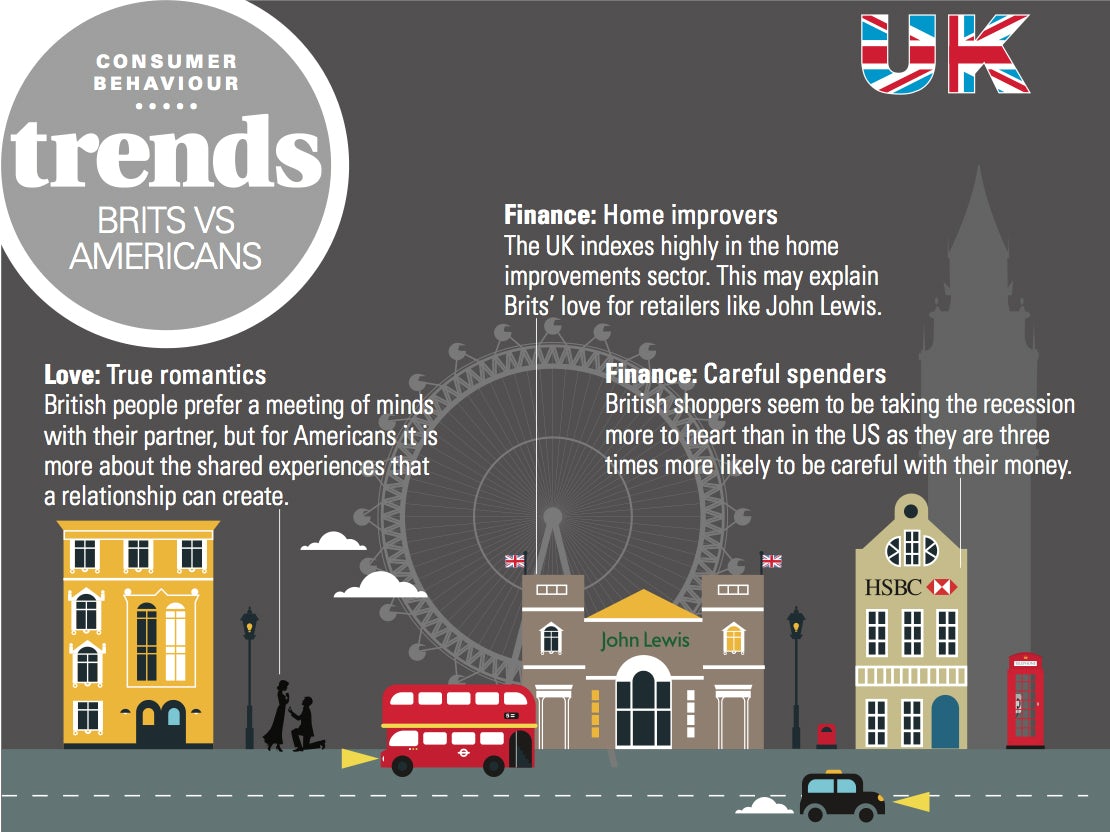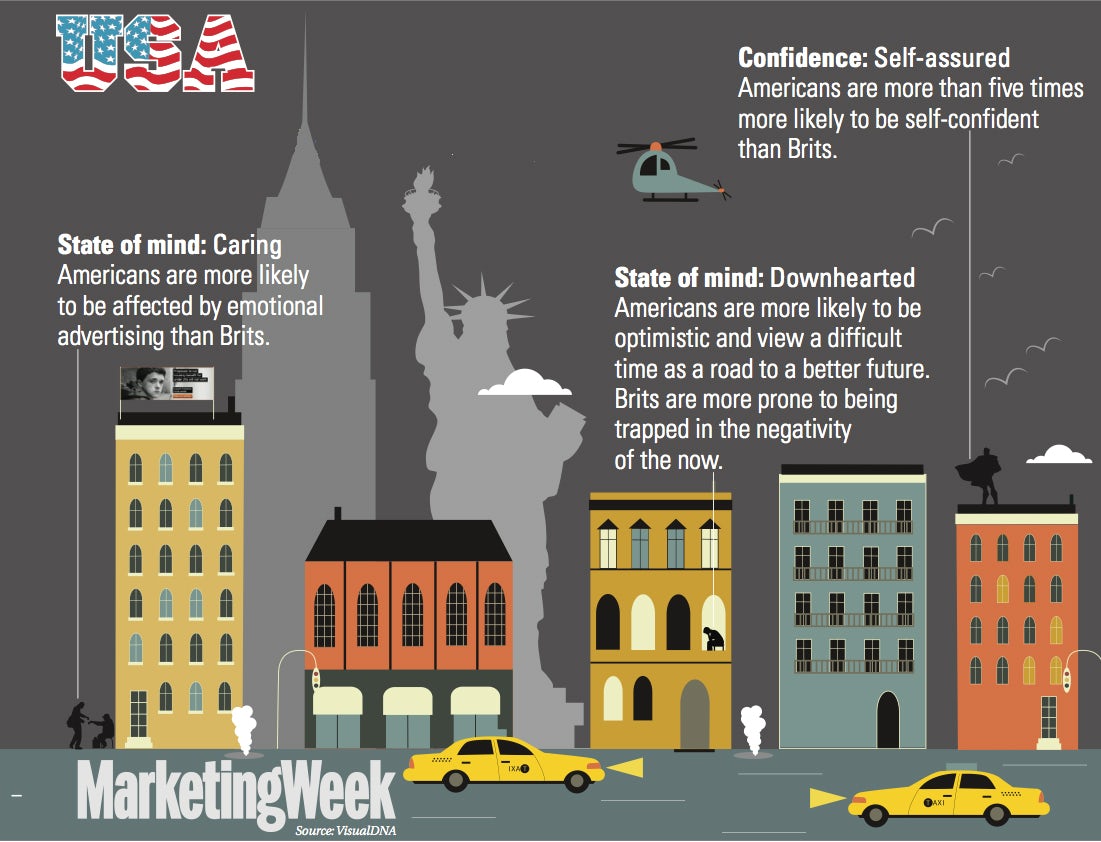How UK and US consumers’ spending habits differ
A personality survey reaffirms the differences between the British and the Americans, facts that marketers can exploit when creating their campaigns.
UK consumers are more pessimistic about the future and have taken the recession more to heart than those in the US, according to exclusive research revealed in Marketing Week.
The report by VisualDNA, which collects data from personality quizzes and is based on indexing, says that the British are three times more likely to be careful spenders than those across the pond, with an index of +3.14.
Research was done with 20,000 consumers, split evenly between the two countries, and its conclusions are both a warning and opportunity for brands. Consumers are generally willing to spend if they think it is worthwhile but will not fritter away their money.
VisualDNA business development director Ed Weatherall says: “Brits like to think they are being more careful with their money. With all the discussions around spending, in the back of their minds they have to be convinced a little bit more about why they should make that purchase.”
Xavier de Lecaros-Aquise, co-founder of dress hire website GirlMeetsDress.com, says his company is likely to benefit from this fact because, “as a rental company, we are always the more affordable option, particularly now that being cost-savvy is on trend”.
Lecaros-Aquise adds: “Americans have always been more comfortable spending money and, for the most part, money they don’t have. Their credit economy is proportionally a lot larger than ours and a lot more tolerated by their credit agencies and government bodies than ours.”
The general reluctance of the British to spend money is echoed in their view of the future. The British ‘over-index’ in being downhearted (+2.59) and, according to the study, this includes people who feel generally defeated by life and as if the world is spinning without them.
Sue Chidler, marketing director at Cath Kidston, believes that “as a nation Americans tend to be more positive and sometimes see things through rose tinted spectacles, but Brits are more pragmatic.”

In both countries there is a strong theme of uncertainty about the future. The research reveals that both share the same big issues: economic turbulence, environmental concerns and digital transition.
“Both UK and US consumers feel uncertainty at the moment, but Americans are more optimistic,” says Weatherall. “They view the current difficulties as a road to a better future, whereas the Brits are trapped in a feeling of negativity about now. This drives people’s level of cynicism towards products and how they are sold.”
The study also reveals that Americans are more than five times more likely to be self-confident than Brits, and more likely to believe in themselves, which, while not surprising, affects consumer spending behaviour.
VisualDNA analyses emotive data derived from personality quizzes (see Methodology, below), so measuring self-confidence helps brands understand the emotional state of consumers.

Weatherall believes that spending behaviour is driven by both the shopping context and consumers’ emotional state because they no longer purchase things for practical reasons. This view suggests that brand differentiation is based on the belief system or values portrayed by the brand, which consumers may connect with depending on their motivation.
“It’s about truly understanding and thinking of customers through that human aspect,” says Weatherall.
GirlMeetsDress.com recently added this “human aspect” to its website, launching a ‘customer moments’ testimonial section and encouraging people to upload photos of themselves in their new dresses.
Lecaros-Aquise says: “Highly engaged visitors who have viewed fellow customer photos are 200 per cent more likely to rent [a dress] than those who have viewed a product shot only on a model. Consumers today are incredibly smart and care about what a product looks like on a real woman.”
Despite recent Christmas tearjerker campaigns in the UK from the likes of John Lewis and Sainsbury’s, the study reveals Americans as more caring and likely to show outward concern than the British. For marketers, this means US consumers are more affected by emotive advertising.
Weatherall says: “It comes down to being honest around brands’ values and if it doesn’t ring true to the belief system or value of the consumer, it’s a big waste of budget.”
Another key difference between the two countries exists in the area of romantic relationships. The research suggests that British people focus on deep-rooted connections and a meeting of minds, while for Americans it is more about the shared experiences that having a partner can provide.

In terms of the relevance for brands, Weatherall says: “It’s about understanding that there are nuances in how people behave. So brands should be thinking about the kind of offers they should be providing to consumers and the language that they should be using.”
For example, a viral campaign that relies on people talking about love, sex and relationships might not work for the British, but it could be more successful with Americans who are generally more romantic and open about these subjects.
Despite the UK’s more pessimistic stance on spending and the future, its personality is not entirely negative. The research reveals an over-indexing in the field of home improvement.
People with an interest in this sector have a domestic focus and spend a lot on large purchases for the home, such as white goods and entertainment systems. They are keen to decorate their home to their own standards and style, and are ready to spend on the goods and services required to achieve this.
With a score of +2.43, the British are two-and-a-half times more likely to be ‘idea seekers’. They aspire to new ways of thinking and believe ideas are the key to both self-development and success.
Marketers regard a group like this as more likely to embrace new technology and products that they think will improve them.
Weatherall says the study shows that brands must switch from analysing consumers in terms of demographics and concentrate instead on their emotional behaviours. A key conclusion from the research is the need for a local focus.
Weatherall says: “Everyone talks about ‘global’ and ‘local’, but people react differently in different regions and it’s a case of digging down and thinking about why that might happen or how things may have to be tweaked slightly for a particular region compared to another.
“You have to take the time to define your customer ‘tribes’, rather than using internally predetermined thoughts. If you look at the UK versus the US, we may speak generally the same language but that’s not enough.”
Methodology
The VisualDNA study looked at 20,000 consumers – 10,000 from the UK and 10,000 from the US – towards the end of 2013.
The research is analysed by indexing, comparing the responses from British and American quiz-takers and highlighting where one side over-indexes the other.
An index of 1 means the results are the same in the UK and the US, so +2 for the UK means that a trait is twice as likely in the UK, while +5 for the US means that Americans are five times more likely to have that characteristic.
The psychographic study – a process of understanding personalities to research consumer lifestyle, behaviours and habits – uses images rather than words. Quiz-takers respond to questions using visuals because using words requires a more functional part of their brain.
Marketers’ response

Xavier de Lecaros-Aquise
Co-founder
GirlMeetsDress.com
The UK is generally more pessimistic because it can never have the economic highs and big success stories experienced by the US. If you look at Facebook, Twitter or Google, they all originated during recessionary times. They have been pillars of customer and employee confidence for American consumers – unlike anything in the UK. The British also have a low threshold for failure and very small appetite for risk. Where the US regards failure as a new beginning from which to build better and stronger, the UK sees it as a sign of what is to come. But the fact that the British are two-and-a-half times more likely to be idea-seekers is really good for us. A big part of our success is our UK customers’ willingness to try new things and embrace the service we offer.

Sue Chidler
Marketing director
Cath Kidston
My experience of a US consumer versus a UK consumer, having worked for American brands in the past is that it’s probably a bit to do with national characteristics. As a nation Americans tend to be more positive and sometimes see things through rose tinted spectacles, but Brits are more pragmatic.
The research shows people pay for things they feel is worth spending their money on, we have just transitioned from sale into the new spring and summer season, and although we have some sale products still available in store, we have seen very quickly how the customer has transitioned from sale into full price. We see that as a positive, that people feel we are worth paying for.
In terms of the pessimism impacting us, from our own research, we know that people find our brand cheers them up. There is something about our brand and its sense of nostalgia that evokes happy memories for people. You could call it an antidote to doom and gloom.






